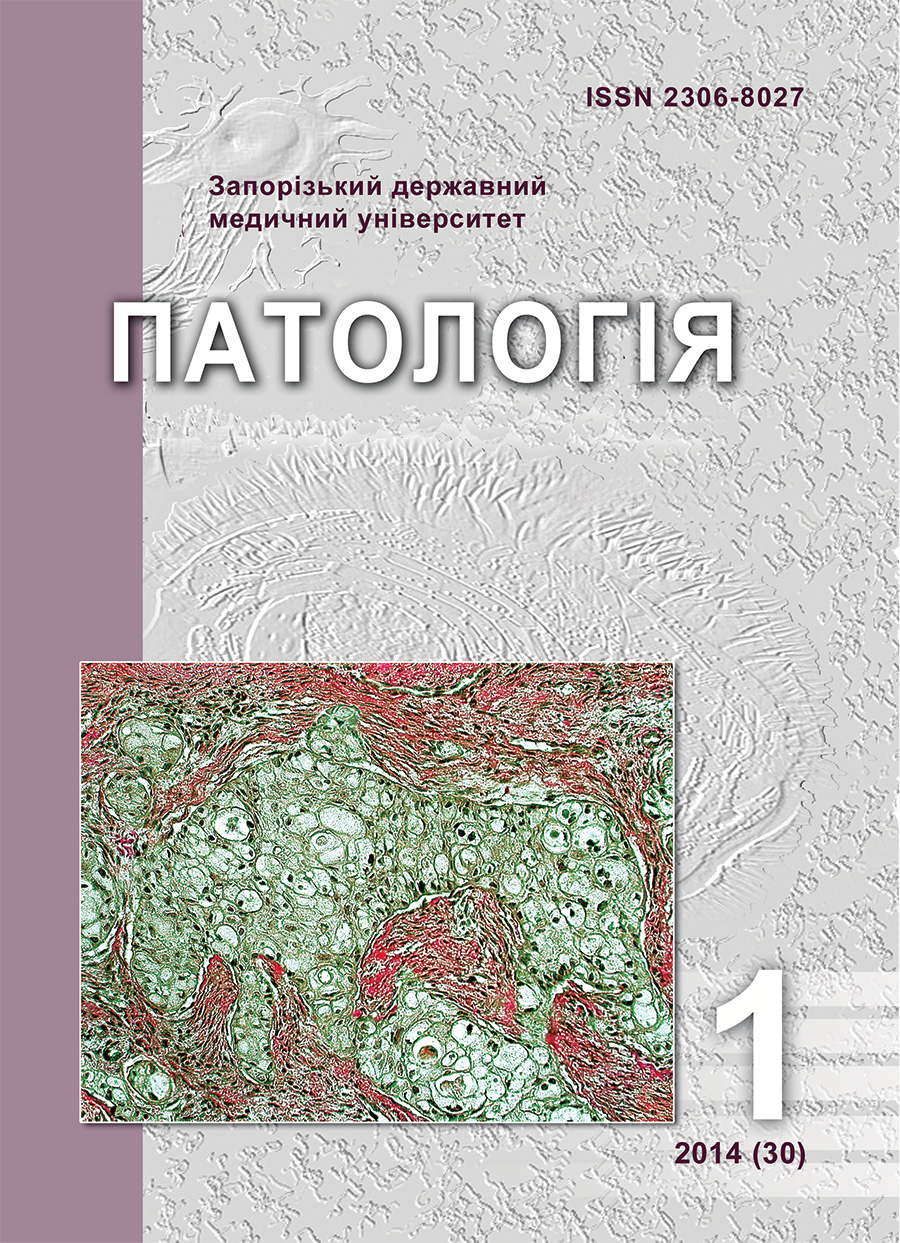Histostructure of pancreas in patients with autoimmune pancreatitis type I and II: connection with the level of IgG4-positive plasma cells
DOI:
https://doi.org/10.14739/2310-1237.2014.1.25584Keywords:
autoimmune pancreatitis type I and II, IgG4, histotopographyAbstract
Aims/hypothesis. The study was undertaken to examine the special aspects of pancreatic histopathology in patients with autoimmune pancreatitis (AIP) type I and II, in connection with the level of IgG4-positive plasma cells (PPC) in the tissue.
Material and methods. The study was conducted on 54 patients with chronic pancreatitis, of whom15 cases with autoimmune pancreatitis were selected. Detailed histological evaluation in three topographical zones of the pancreas (head, body and tail) was carried out for each case.
Results and interpretation. AIP type I was found in five cases. In all cases in pancreas (all three zones) stages III-IV of AIP were observed with characteristic dense lymphocytic and plasma cells infiltration, multilevel fibrosis and obliterating phlebitis. In the liver hepatitis was observed with a slight fibrosis and plasma cells infiltration (up to 5-PPC per high power field), IgG4-PPC were located in dilated portal tracts. The high level of IgG-PPC and IgG4-PPC in the pancreatic tissue (≥ 30 IgG4-PPC per high power field) also confirmed the diagnosis of AIP type I, as IgG4-associated sclerosing disease. These patients had a diffuse damage of the pancreas at III (3 cases) and IV (2 cases) stages. All cases were marked by complicated disease course of AIP: in 60% (3 people) – a chronic fibrocystic pancreatitis, and 40% (2 people) – a chronic calculus pancreatopathy. In all the patients with AIP type I the dense plasma cells infiltrate around main and interlobular ducts and pancreatic lymph follicles was found with compact clusters of IgG4-PPC (≥ 30 IgG4-PPC per high power field).
AIP type II was found in other 10 cases. Two of them were characterized by diffuse, and eight – by the focal form of AIP. Stage IV of AIP was detected in one patient with the total damage of pancreas, and the AIP on II stage of development in another. AIP activity in these patients was minimal. Focal form of AIP type II which was located in the body of the pancreas (II-III stage AIP) was observed in three cases, in the tail (I and II Stage AIP) – in two cases, and in the head – in one case (I stage AIP). Another two cases showed conjoined destruction of the body and tail (II stage).
In the focal form of AIP type II in epithelium of main pancreatic duct, collecting ducts and acini single and multiple neutrophilic leukocytes were observed, including the formation of microabscesses. Areas of desquamation, epithelial mitotic figures were observed in ductal epithelium. Suchlike high activity of AIP type II was observed in half of the cases. Lymphocytic and plasma cells infiltration was located not only in the ducts area but also in the stroma and lobules. For AIP type II at stages III-IV obliterating phlebitis located in the fibrous tissue was typical. In periductal fibrous tissue clusters of IgG PPC were identified. All cases show focal compact clusters of IgG4-PPC in periductal, perilobular and fibrotic tissue. IgG4-PPC were counted to the limit of 5-10 per high power field.
Conclusions. Autoimmune pancreatitis type I is marked by dense lymphocytic and plasma cells infiltrate in periductal zone, multilevel fibrosis, obliterating venulitis and a high level of IgG4-PPC in the pancreas (≥ 30 IgG4-PPC per high power field). Autoimmune pancreatitis type II, in addition to the known histopathologic features of AIP, was defined by neutrophilic leukocyte epithelial damage of pancreatic ducts and low level of IgG4-PPC in the pancreas. For AIP type II in 80% of cases focal damage of the pancreas at stage I-III was typical. In perspective those findings will lead to developing of simple and affordable diagnostic for AIP type I and II.
References
Yoshida, K., Toki, F., Takeuchi, T., Watanabe, S., Shiratori, K.& Hayashi, N. (1995). Chronic pancreatitis caused by an autoimmune abnormality. Digestive diseases and sciences, 40(7), 1561–1568.
Zamboni, G., Luttges, J., Capelli, P., Frulloni, L., Cavallini, G., Pederzoli, et al. (2004). Histopathological features of diagnostic and clinical relevance in autoimmune pancreatitis: a study on 53 resection specimens and 9 biopsy specimens. Virchows Archiv, 445(6), 552–563.
Notohara, K., Burgart, L., Yadav, D., Chari, S. & Smyrk, T. (2003). Idiopathic chronic pancreatitis with periductallymphoplasmacytic infiltration: clinicopathologic features of 35 cases. The American journal of surgical pathology, 27(8), 1119–1127.
Sato, Y., Notohara, K., Kojima, M., Takata, K., Masaki, Y. & Yoshino, T. (2010). IgG4-related disease: Historical overview and pathology of hematological disorders. Pathology international, 60(4), 247 –258. doi: 10.1111/j.1440 1827.2010.02524.x.
Shimosegawa, T., Chari, S., Frulloni, L., Kamisawa, T., Kawa, S., et al. (2011). International consensus diagnostic criteria for autoimmune pancreatitis: guidelines of the International Association of Pancreatology. Pancreas, 40(3), 352–358. doi: 10.1097/ MPA.0b013e3182142fd2.
Deshpande, V. (2012). The pathology of IgG4-related disease: critical issues and challenges. Seminars in diagnostic pathology, 29(4), 191–196. doi:10.1053/j.semdp.2012.08.001.
Ikeura, T., Takaoka, M., Uchida, K., Shimatani, M., Miyoshi, H., et al. (2011). Autoimmune pancreatitis with histologically proven lymphoplasmacyticsclerosing pancreatitis with granulocytic epithelial lesions. Internal medicine, 51(7), 733–737.
Downloads
How to Cite
Issue
Section
License
Authors retain copyright and grant the journal right of first publication with the work simultaneously licensed under a Creative Commons Attribution License that allows others to share the work with an acknowledgement of the work's authorship and initial publication in this journal.



